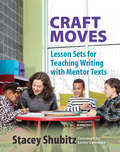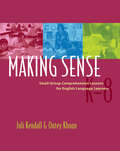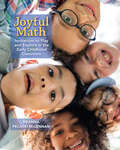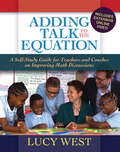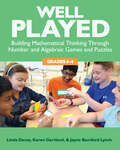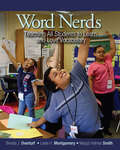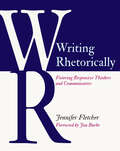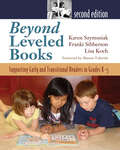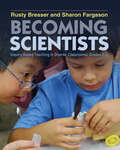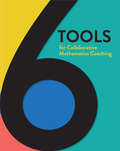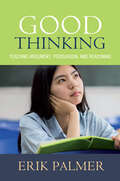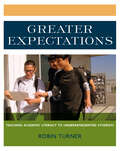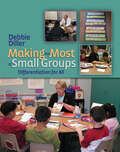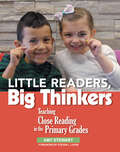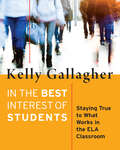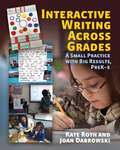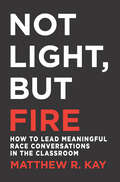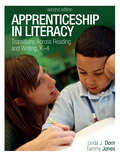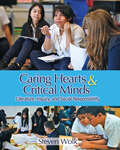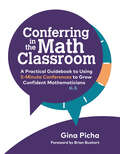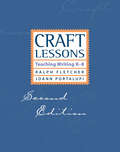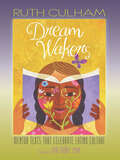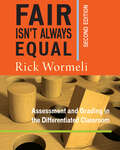- Table View
- List View
Craft Moves: Lesson Sets for Teaching Writing with Mentor Texts
by Stacey ShubitzHow do you choose mentor texts for your students? How do you mine them for the craft lessons you want your students to learn?In Craft Moves: Lesson Sets for Teaching Writing with Mentor Texts , Stacey Shubitz, co-founder of the Two Writing Teachers website, usestwenty recently published picture books to createmore than 180 lessons to teach various craft moves that will help your students become better writers.Each of the 184 lessons in the book includes a publisher's summary, a rationale or explanation of the craft move demonstrated in the book, and a procedure that takes teachers and students back into the mentor text to deepen their understanding of the selected craft move. A step-by-step guide demonstrates how to analyze a picture book for multiple craft moves.Shubitzintroduces picture books as teaching tools and offers ways to integrate them into your curriculum and classroom discussions. She then shares different routines and classroom procedures designed to help students focus on their writing during the writer's workshop as well as focusing how teachers can prepare for small group instruction.Using picture books as mentor texts will help your students not only read as writers and write with joy but also become writers who can effectively communicate meaning, structure their writing, write with detail, and give their writing their own unique voice.
Making Sense: Small-Group Comprehension Lessons for English Language Learners
by Juli Kendall Outey KhuonReading is all about understanding. How do we know our kids are getting it—and what do we do when they don't get it? Authors Juli Kendall and Outey Khuon believe that small group comprehension lessons have a key role to play in advancing students' understanding of texts. Making Sense: Small-Group Comprehension Lessons for English Language Learners , they provide answers to many common questions asked by teachers of ELL. It is an easy-to-use, practical resource for ELD, ESL, and ESOL teachers.The book's five main sections are geared to the stages of language proficiency, and lessons span kindergarten through grade 8. The authors outline 52 lessons that teach students how to make connections, visualize, infer, and determine importance. Each lesson follows a four-part teaching framework: Start Up/Connection: Helping students build background and use prior knowledge to connect to the lesson Give Information : Explicitly telling students what they are going to learn and why they are learning it Active Involvement : Students practice what they are learning while the teacher monitors and adjusts instruction accordingly Off-You-Go!: Opportunities for students to practice what they learned with peers or independently. Making Sense will appeal to experienced teachers seeking to expand their repertoire of lessons, as well as new teachers just beginning the adventure of teaching comprehension to English language learners.
Joyful Math: Invitations to Play and Explore in the Early Childhood Classroom
by Deanna Pecaski McLennanIf you've ever wished that learning math could be more joyful and playful for young learners, you're not alone. In Joyful Math: Invitations to Play and Explore in the Early Childhood Classroom, kindergarten teacher Deanna Pecaski McLennan opens her classroom doors to share the practical, yet innovative ways she integrates mathematical play throughout the school day. Each chapter of this easy-to-navigate, photo-filled book focuses on specific strategies, activities and examples of mathematical play within literacy, art, and outdoor explorations. Inside Joyful Mathyou'll find: A photo guide, including suggested tools and materials, to setting up a classroom environment and space that fosters mathematical curiosity and joyDozens of open-ended and teacher-guided mathematical activities that are simple to set up and full of mathematical possibilityPractical tips for including mathematical play across the daySuggestions and examples of ways to document and share children's learning experiences with families and communitiesJoyful Math will inspire educators to make space for joy and play in early childhood mathematics and give them the tools to make this vision a reality.
Adding Talk To The Equation: A Self-Study Guide for Teachers and Coaches on Improving Math Discussions
by Lucy WestFor more than 20 years, Lucy West has been studying mathematical classroom discourse. She believes that teachers need to understand what their students are thinking as they grapple with rich mathematical tasks and that the best way to do so is through talking and listening. In this video-rich edition of Adding Talk to the Equation: Discussions and Discovery in Mathematics, she invites teachers into real-life classrooms where all students stay in the game, stay motivated about learning, and ultimately deepen their understanding. Designed for math teachers and coaches in grades 18, this self-study guide showcases elementary and middle school classrooms where teachers inspire even the most reluctant students to share their ideas. Through the stories of skilled teachers, West offers play-by-play commentary as they get more comfortable with new talk moves and learn to tune in and respond to students' math conversations. Although these discussions occur in math class, the strategies can be used to create a respectful, productive environment for any subject area. This video-based resource examines the importance of creating a safe learning environment; the value of thinking, reasoning, and questioning; the role of active, accountable listening; and the necessity of giving all students a you can do this message. West also emphasizes that slowing down, even in the face of time constraints, is crucial for creating a classroom where all students feel they have something to contribute. This guide includes transcripts of the case studies, with insightful commentary from West that gives you a window into her thinking and the complexities of the work she is doing with teachers, as well as her reflections on missed opportunities.
Well Played, Grades 6-8: Building Mathematical Thinking Through Number and Algebraic Games and Puzzles
by Linda Dacey Karen Gartland Jayne Bamford LynchStudents love math games and puzzles, but how much are they really learning from the experience? Too often, math games are thought of as just a fun activity or enrichment opportunity. Well Played, Grades 6-8: Building Mathematical Thinking Through Number and Algebraic Games and Puzzles shows you how to make games and puzzles an integral learning component that provides teachers with unique access to student thinking. This third book in the series helps you engage students in grades 6-8 in discussions of mathematical ideas and deepen their conceptual understanding. It also helps you develop students' fluency with number systems; ratio and proportional relationships; expressions and equations, statistics and probability; and patterns, graphs, and functions. The twenty-five games and puzzles in Well Played, Grades 6-8 which have all been field-tested in diverse classrooms, contain: Explanations of the mathematical importance of each game or puzzle and how it supports student learning. Variations for each game or puzzle to address a range of learning levels and styles Classroom vignettes that model how best to introduce the featured game or puzzle. The book also includes a separate chapter with suggestions for how to effectively manage games and puzzles in diverse classrooms; game boards, game cards, and puzzles; assessment ideas; and suggestions for online games, puzzles, and apps. Well Played, Grades 6-8 will help you tap the power of games and puzzles to engage students in sustained and productive mathematical thinking.
Word Nerds: Teaching All Students to Learn and Love Vocabulary
by Brenda L. Overturf Leslie Montgomery Margot Holmes SmithWord mastery comes from intimate knowledge of language. In Word Nerds : Teaching All Students to Learn and Love Vocabulary, authors Leslie Montgomery and Margot Holmes Smith take you inside classrooms where they implement creative, flexible vocabulary instruction that improves their students' word knowledge and confidence. With support from literacy specialist Brenda Overturf, the authors developed a five-part plan to teach all students to learn vocabulary: Introducing new words in contextAdding related synonyms and antonymsEngaging in several days of active learningCelebrating new wordsAssessing vocabulary developmentThis easy-to-read reference explains how to plan, teach, and assess based on the latest research in vocabulary instruction and learning. After incorporating the authors' plan, you can be a Word Nerd too!
Writing Rhetorically: Fostering Responsive Thinkers and Communicators
by Jennifer FletcherWriting Rhetorically: Fostering Responsive Thinkers and Communicators, author Jennifer Fletcher aims to cultivate independent learners through rhetorical thinking. She provides teachers with strategies and frameworks for writing instruction that can be applied across multiple subjects and lesson plans. Students learn to discover their own questions, design their own inquiry process, develop their own positions and purposes, make their own choices about content and form, and contribute to conversations that matter to them. Inside this book, Fletcher helps remove some of the scaffolding and explains how to put in practice some methods which can successfully foster: Inquiry, Invention, and Rhetorical Thinking Writing for Transfer Paraphrasing, Summary, Synthesis, and Citation Skills Research Skills and Processes Evidence-Based Reasoning Rhetorical Decision Making' Rhetorical decision making helps students develop the skills, knowledge, and mindsets needed for transfer of learning: the ability to adapt and apply learning in new settings. The more choices students make as writers, the better prepared they are to analyze and respond to diverse rhetorical situations.' Writing Rhetorically' shows teachers what it looks like to dig into real texts with students and novice writers and how it develops them for lifelong learning.
Beyond Leveled Books: Supporting Early and Transitional Readers in Grades K-5
by Franki Sibberson Karen Szymusiak Lisa KochIn Beyond Leveled Books, Second Edition, Franki Sibberson, Karen Szymusiak, and Lisa Koch provide even more resources to help teachers understand and meet the needs of transitional readers. The key topic of series books has been revised and enlarged, with charts outlining new series with the challenges they pose and supports readers need. New lessons have been added, and most chapters now include a related article from a literacy expert. Some of the contributors include Kathy Collins, Larry Swartz, and Mary Lee Hahn.Leveled books are an indispensable tool for teaching children to read, especially for emergent readers, but the authors of Beyond Leveled Books are sounding the alarm about the overuse and misuse of leveling and the way it restricts teacher autonomy and undermines student choice and reading engagement. The authors lay out a blueprint for using leveled books effectively within a student-centered and differentiated approach that is designed to motivate all readers, particularly transitional ones. Teaching Transitional Readers: Beyond Leveled Books is packed with resources to help teachers understand and meet the needs of transitional readers, including examples of classroom instruction, sample mini-lessons, strategies for small-group instruction, assessment techniques, and articles by literacy expertsResources for K-5 Classrooms: The book explores the uses and limitations of leveled texts in primary reading instruction, including ideas for how to organize your classroom library and a list of great books and series to use alongside leveled text in supporting new readersGateway to Independent Reading: The authors provide explicit tools for helping students consolidate their skills and reading strategies, to read widely and deeply, to increase their vocabulary, and build critical thinkingMaking Reading Fun: Teach students to experience joy from reading through deeper comprehension and applicationBeyond Leveled Books is an essential resource for K-5 teachers looking to help all readers, including budding readers, struggling readers, transitional readers, and readers who have plateaued.
Becoming Scientists: Inquiry-Based Teaching in Diverse Classrooms, Grades 3-5
by Rusty Bresser Sharon FargasonMost important to being a good science teacher is holding the expectation that all students can be scientists and think critically. Providing a thinking curriculum is especially important for those children in diverse classrooms who have been underserved by our educational system. -; Becoming Scientists Good science starts with a question, perhaps from the teacher at the start of a science unit or from the children as they wonder what makes a toy car move, how food decomposes, or why leaves change color. Using inquiry science, children discover answers to their questions in the same way that scientists do-;they design experiments, make predictions, observe and describe, offer and test explanations, and share their conjectures with others. In essence, they construct their own understanding of how the world works through experimentation, reflection, and discussion. Look into real classrooms where teachers practice inquiry science and engage students in the science and engineering practices outlined in the Next Generation Science Standards. Rusty Bresser and Sharon Fargason show teachers how to do the following: Build on students' varied experiences, background knowledge, and readiness Respond to the needs of students with varying levels of English language proficiency Manage a diverse classroom during inquiry science exploration Facilitate science discussions Deepen their own science content knowledgeAs the authors state, Inquiry science has little to do with textbooks and lectures and everything to do with our inherent need as a species to learn about and reflect on the world around us. Join your students on a journey of discovery as you explore your world via inquiry.
6 Tools for Collaborative Mathematics Coaching
by Nicora PlacaIn 6 Tools for Collaborative Mathematics Coaching , Nicora Placa lays out a clear path to help you become a trusted and effective math coach. Her 6 Tools- are flexible structures that you and your colleagues can use to learn together: Building Teams: Fostering a Learning Community Student Interviews: Learning to Listen Visiting Classrooms: Developing Your Lens Learning Walks: Focusing the Team on Students' Thinking Rehearsing Routines: Practicing with Colleagues Lesson Study: Learning Collectively with Voice, Choice, and Agency In this easy-to-use, practical guide, Placa introduces each of the 6 Tools with classroom vignettes, step-by-step guidelines for rollout, connections to the literature, resources for further research, planning templates, and opportunities for you to adapt the tool for your particular context. Whether you're a new coach who loves teaching math to children but is new to adult education, or a more experienced coach who is looking for new strategies to engage your teams, 6 Tools for Collaborative Mathematics Coaching can help you create learning opportunities that honor teachers as professionals. With a collaborative coaching approach, you can improve teaching and learning across your school and for all your students.There's so much to love about how 6 Tools is constructed. --Elham Kazemi
Good Thinking: Teaching Argument, Persuasion, and Reasoning
by Erik PalmerOur daily communication involves argumentation and reasoning, but how well do we prepare students for these tasks? Are they able to persuade others, make solid purchasing decisions, or analyze the messages in the media? In his new book, Good Thinking: Teaching Argument, Persuasion, and Reasoning, Erik Palmer shows teachers of all subject matters how to transform the activities they already use into openings for improving student thinking. He demonstrates how to critically evaluate a point of view, understand rhetorical devises, apply logic, and build an effective argument, written or oral. Blending theory with practice, Palmer shares a wide range of classroom-tested lessons, including:How to understand argument in paintings and images Addressing ad hominem attacks using a traveling debate Creating a class comedy club, where students write syllogisms and analyze character and plot development Teaching logic through a class 'Booger Patrol' Palmer explains complex concepts in simple, practical language that gives teachers a deft understanding of the principles of good arguments, proper use of evidence, persuasive techniques, and rhetorical tricks. He reveals how all students, not just those in advanced classes, can begin developing sophisticated reasoning skills that will improve their oral and written communications, both in and outside of the classroom. '
Greater Expectations: Teaching Academic Literacy to Underrepresented Students
by Robin TurnerWhile the population of Hispanic/Latino and African American students in the United States continues to grow, the rate at which they attend college remains alarmingly small. These students, who are often defined as educationally underrepresented, are a bellwether of a shortcoming in our nation' s educational system that has serious implications for the future. In Greater Expectations: Teaching Academic Literacy to Underrepresented Students, author and teacher Robin Turner offers pragmatic, proven methods for better preparing underrepresented students for higher education. Forming the book' s foundations are the ideas of família and cariño, or family and caring. Familia asserts the importance of establishing a sense of community and tapping into student culture – ethnicity, music, sports, neighborhood and so on in the language arts classroom Cariño contends that underrepresented students possess attributes that are overlooked and are viewed with a deficit-model paradigmBuilding on this foundation, Greater Expectations shows how to effectively teach different modes of academic discourseliterary analysis, autobiographical/biographical, persuasive research, and community-based writing. Offering a combination of personal narrative, how-to lesson plans, and student samples, Turner challenges readers to approach their underrepresented students with greater expectations and be equipped with specific lesson plans to enable their classes to meet them. The books is grounded in, and inspired by, Turner's experience as a leader in the Puente Project, a college preparation program started in California high schools over twenty years ago. Since 1981, Puente has proven highly effective in producing positive change by improving academic performance, standardized test scores, and college admission rates for underrepresented students.
Making the Most of Small Groups: Differentiation for All
by Debbie DillerAuthor Debbie Diller turns her attention to small reading groups and the teacher's role in small-group instruction. Making the Most of Small Groups: Differentiation for All grapples with difficult questions regarding small-group instruction in elementary classrooms such as: How do I find the time? How can I be more organized? How do I form groups? How can I differentiate to meet the needs of all of my students? Structured around the five essential reading elements—comprehension, fluency, phonemic awareness, phonics, and vocabulary—the book provides practical tips, sample lessons, lesson plans and templates, suggestions for related literacy work stations, and connections to whole-group instruction. In addition to ideas to use immediately in the classroom, Diller provides an overview of relevant research and reflection questions for professional conversations.
Little Readers, Big Thinkers: Teaching Close Reading in the Primary Grades
by Amy StewartYoung learners are full of questions and wonderings, so much so that sometimes they need a guide for their curiosity. Author Amy Stewart brings her manageable approach to close reading in Little Readers, Big Thinkers: Teaching Close Reading in the Primary Grades . With Stewart guiding, you'll be able to harness the big thinking we know is inside their inquisitive minds.She showcases ways that close reading can teach even the youngest students new ways to enjoy texts, think about them critically, and share that thinking with peers and adults.With its description of the pillars of close reading, multiple lesson sequences for grades K-2, and real-life classroom scenarios, Little Readers, Big Thinkers offers a trove of insights: What close reading is (and is not )How to encourage students to read like detectives-Ways to weave close reading practices into your lessonsHow to cultivate real reading, organic thinking, and deep conversationWhich books invite amazing learning and thinking experiencesBy giving young minds a great foundation, close reading will become a stepping stone to a lifelong love of reading.
In the Best Interest of Students: Staying True to What Works in the ELA Classroom
by Kelly GallagherIn his new book,In the Best Interest of Students: Staying True to What Works in the ELA Classroom , teacher and author Kelly Gallagher notes that there are real strengths in the Common Core standards, and there are significant weaknesses as well. He takes the long view, reminding us that standards come and go but good teaching remains grounded in proven practices that sharpen students' literacy skills.Instead of blindly adhering to the latest standards movement, Gallagher suggests:Increasing the amount of reading and writing students are doing while giving students more choice around those activitiesBalancing rigorous, high-quality literature and non-fiction works with student-selected titlesEncouraging readers to deepen their comprehension by moving beyond the four corners of the text-Planning lessons that move beyond Common Core expectations to help young writers achieve more authenticity through the blending of genresUsing modeling to enrich students' writing skills in the prewriting, drafting, and revision stagesResisting the de-emphasis of narrative and imaginative reading and writingAmid the frenzy of trying to teach to a new set of standards, Kelly Gallagher is a strong voice of reason, reminding us that instruction should be anchored around one guiding question: What is in the best interest of our students?
Interactive Writing Across Grades: A Small Practice with Big Results
by Kate Roth Joan DabrowskiWhen done on a regular basis, interactive writing has the potential to improve independent writing. Authors Kate Roth and Joan Dabrowski detail how this systemic approach can be applied in Interactive Writing Across Grades: A Small Practice with Big Results, PreK-5.' Interactive writing harnesses the natural interactions teachers have with their students as they compose a writing piece. It allows for real-time differentiation and tailored scaffolding. This method fits within any basal writing curriculum and can be adapted to your classroom's technology levels. This book acts as a how-to guide that unpacks this powerful method, going step-by-step and grade-by-grade to figure out where and how interactive writing fits within your literacy framework. Inside you'll find:A complete overview of the interactive writing method and how it fits into your balanced literacy program Concrete ways to launch interactive writing in your classroom to support both process and craft instruction Step-by-step guidance to implement the method with students of all ages Student examples of writing from grades Pre-K through 5 to show what to expect at each phase of the process 'Listen in on a Lesson vignettes that demonstrate the type of scaffolding you can offer during interactive writing lessons Discover what makes interactive writing a particularly effective teaching practice that can support both emergent and fluent writers. Interactive Writing Across Grades can help put this method to work in the classroom immediately. '
Math Work Stations: Independent Learning You Can Count On, K-2
by Debbie DillerIf you' ve ever questioned how to make math stations work, you' ll find this photo-filled, idea-packed resource invaluable. This book extends Debbie Diller' s best-selling work on literacy work stations and classroom design to the field of mathematics. In Math Work Stations you' ll find ideas to help children develop conceptual understanding and skills, use math vocabulary as they talk about their mathematical thinking, and connect big ideas to meaningful independent exploration and practice. This book details how to set up, manage, and keep math stations going throughout the year. There' s even a chapter devoted solely to organizing and using math manipulatives. Each chapter includes: key concepts based on NCTM and state math standards; math vocabulary resources and literature links; suggested materials to include at each station for the corresponding math content strand; ideas for modeling, troubleshooting, differentiating, and assessment; and reflection questions for professional development.Throughout the book, Debbie has included hundreds of color photos showing math work stations in action from a variety of classrooms in which she has worked. Charts, reproducible forms, and math work stations icons are included to provide everything you' ll need to get started with stations in your classroom right away.
Not Light, but Fire: How to Lead Meaningful Race Conversations in the Classroom
by Matthew KayDo you know how to initiate and facilitate productive dialogues about race in your classroom? Are you prepared to handle complex topics while keeping your students engaged?Inspired by Frederick Douglass's abolitionist call to action, it is not light that is needed, but fire-, author Matthew Kay demonstrateshow to move beyond surface-level discussionsand lead students through the most difficult race conversations. In Not Light, But Fire: How to Lead Meaningful Race Conversations in the Classroom, Kay recognizes we often never graduate to the harder conversations,so he offers a method for getting them right, providing candid guidance on: How torecognize the difference between meaningful and inconsequential race conversations.How tobuild conversational safe spaces,- not merely declare them.How toinfuse race conversations with urgency and purpose.How tothrive in the face of unexpected challenges.How administrators mightequip teachers to thoughtfully engage in these conversations.With the right blend of reflection and humility, Kay assertsteachers can make school one of the best venues for young people to discuss race.
Apprenticeship in Literacy: Transitions Across Reading and Writing, K-4
by Linda Dorn Tammy JonesGrounded in social and cognitive learning theories, the second edition of Apprenticeship in Literacy: Transitions Across Reading and Writing, K-4 still details the seven principles of apprenticeship learning and helps K -4 teachers implement and assess guided reading, assisted writing, literature discussion groups, word study lessons, and literacy centers across an integrated curriculum. The new edition also features the following: Updated research emphasizing the importance of early reading as a road map for successInformation on how behaviors, from emergent to fluent, align to the Common Core State StandardsDozens of new classroom examples-;students' work, photographs, transcripts, teacher-student conferences, and reproducible resourcesLanguage prompts that promote self-regulated learnersSchedules for implementing a workshop framework in whole-group, small-group, and one-to-one settingsSuggestions for incorporating information texts into a balanced literacy programStronger emphasis on the importance of the writing processAdditional ideas on establishing routines and organizing the classroomThe theme of apprenticeship in literacy resonates throughout the book: children learn from teachers and teachers learn from one another as they promote children's transfer of knowledge across multiple contexts. The final chapter provides real-world examples of teachers working together to ensure that all children become literate.Since its original publication in 1998, Apprenticeship in Literacy has become a teacher favorite, covering all aspects of a balanced literacy program in an integrated manner and showing how all components are differentiated to address the needs of diverse learners. An apprenticeship approach to literacy emphasizes the role of the teacher in providing demonstrations, engaging children, monitoring their understanding, providing timely support, and ultimately withdrawing that support as the child gains independence.
Boy Writers: Reclaiming Their Voices
by Ralph FletcherWriting test scores indicate that boys have fallen far behind girls across the grades. In general, boys don't enjoy writing as much as girls. What's wrong? How can we do a better of job of creating boy-friendly classrooms so their voices can be heard? In Boy Writers: Reclaiming Their Voices Ralph Fletcher draws upon his years of experience as staff developer, children's book author, and father of four boys. He also taps the insights from dozens of writing teachers around the US and abroad. Boy Writers asks teachers to imagine the writing classroom from a boy's perspective, and consider specific steps we might take to create stimulating classrooms for boys. Topic choice emerges as a crucial issue. The subjects many boys like to write about (war, weapons, outlandish fiction, zany or bathroom humor) often do not get a warm reception from teachers. Fletcher argues that we must widen the circle and give boys more choice if we want to engage them as writers. How? We must begin by recognizing boys and the world in which they live. Boy Writers explores important questions such as: What subjects are boy writers passionate about, and what motivates them as writers? Why do boys like to incorporate violence into their stories, and how much should be allowed? Why do we so often misread and misunderstand the humor boys include in their stories? In addition, the book looks at: how handwriting can hamstring boy writers, and how drawing may help; welcoming boy-friendly writing genres in our classrooms; ways to improve our conferring with boys; and more. Each chapter begins with a thorough discussion of a topic and ends with a highly practical section titled: "What can I do in my classroom?" Boy Writers does not advocate promoting the interests of boys at the expense of girls. Rather, it argues that developing sensitivity to the unique facets of boy writers will help teachers better address the needs of all their students.
Caring Hearts and Critical Minds: Literature, Inquiry, and Social Responsibility
by Steven WolkImagine if going to school meant more than preparing kids for a test, teaching a canned curriculum, and training students for their future as workers. What if school were also about cultivating students to be caring, community-involved citizens and critical, creative thinkers who love to read? In Caring Hearts & Critical Minds, teacher-author Steven Wolk shows teachers how to help students become better readers as well as better people. I want [my students] to be thinkers and have rich conversations regarding critical issues in the text and be able to formulate opinions regarding these issues, says Leslie Rector, a sixth-grade teacher who collaborated with Wolk on some of the units featured in this book. Wolk demonstrates how to integrate inquiry learning, exciting and contemporary literature, and teaching for social responsibility across the curriculum. He takes teachers step-by-step through the process of designing an inquiry-based literature unit and then provides five full units used in real middle-grade classrooms. Featuring a remarkable range of recommended resources and hundreds of novels from across the literary genres, Caring Hearts & Critical Minds gives teachers a blueprint for creating dynamic units with rigorous lessons about topics kids care about'sfrom media and the environment to personal happiness and global poverty. Wolk shows teachers how to find stimulating, real-world complex texts called for in the Common Core State Standards and integrate them into literature units. I know from experience that a great book changes the reader, says Karen Tellez, an eighth-grade teacher featured in the book. For me, books have helped me escape, fall in love, recover from heartbreak, and have broken open my mind from the age of twelve. . . . I hope [my students] gain better reading comprehension, confidence as readers, connections to the characters and events, a curiosity for the world, and tolerance for others. Caring Hearts & Critical Minds shows teachers how to turn these hopes and goals into reality.
Conferring in the Math Classroom: A Practical Guidebook to Using 5-Minute Conferences to Grow Confident Mathematicians
by Gina PichaAll students enter our math classrooms with ideas worthy of discussion. Some of the most effective breakthroughs come from short, intentional conversations between students and teacher, yet planning for these moments can seem daunting. In her innovative book, Conferring in the Math Classroom: A Practical Guidebook to Using 5-Minute Conferences to Grow Confident Mathematicians, Gina Picha focuses on simple and transformative ways teachers can use math conferences, short conversations between teachers and small groups of students at work, to guide instruction, assess understanding, and build strong math thinkers. Inside you will learn to: Facilitate math conferences to listen to students, identify and build on their strengths, and encourage them to share their math thinking Build a positive math identity that will help nurture student-centered math classrooms Ask exploratory questions to gain data-driven insight into their math reasoning and plan the next steps for instruction Provide differentiated math instruction based on the individual or small group needs Drive fun and interactive math talk in the classroom Picha includes teacher questioning guides, If-Then charts organized by grade level and math topic, and note-taking templates to help you get started with math conferring right away. This practical and highly accessible approach can help students deepen their math understanding, build confidence in their math abilities, and connect learnings between math subjects.
Craft Lessons: Teaching Writing K-8
by Ralph Fletcher JoAnn PortalupiSince its publication in 1998 Craft Lessons has become a staple in the writing classroom of both new and experienced teachers. Authors Ralph Fletcher and JoAnn Portalupi recognized the need for a succinct resource and teamed together to write the second edition of Craft Lessons: Teaching Writing K-8 . Teachers pressed for time will appreciate the practical lessons and instructional language geared to three grade level groupings: K-2, 3-4, and 5-8. This edition includes: 17 brand new lessons; mini lessons designed from teachers&’ comments about what is observed students&’ writing Revisions to other craft lessons and the resource materials sections have been expanded New ways to approach teaching using elements of craft and the reading-writing connection A subject index to find specific craft lessons with ease The authors&’ thoughts about how craft lessons fit into their newest thinking about the qualities of writing: Ideas, Design, Language, and Presentation The 95 lessons in this book provide a wealth of information for teaching leads, character, endings, stronger verbs, and much more. This new edition reestablishes Craft Lessons as the crucial desert island book for harried writing teachers everywhere
Dream Wakers: Mentor Texts That Celebrate Latino Culture
by Ruth CulhamThere is power that resides in outstanding culturally diverse literature'sa power that has the potential to engage students in reading and teach them about the art and craft of writing. 'sRuth Culham We dream of a time when all students will be confident, capable readers and writers. When we teach students to read as writers using mentor texts, we awaken that dream and make it real. Imagine the power of providing students with books that show them their faces, their culture, their lives on every page. And imagine how every classroom's collection of mentor texts can grow by adding books that celebrate diversity. In Dream Wakers: Mentor Texts That Celebrate Latino Culture, Ruth Culham focuses her love of children's literature'sand her decades of work developing the traits of writing'son books that celebrate Latino life and culture. She provides a wide variety of ideas to teach writing using some of the richest and most beautiful children's books available. Dream Wakers gives you: • An annotated list of more than 120 books with do-it-today lesson ideas for teaching the traits of writing'sIdeas, Organization, Voice, Word Choice, Sentence Fluency, and Conventions. More than half of the books listed are bilingual or offer English and/or Spanish editions. • Eleven original, insightful essays by renowned children's authors of some of the featured books • A handy reference chart that helps teachers locate books quickly by trait, genre, language, and author/publisher information. Ruth encourages all of us to make sure students of all backgrounds have access to high-quality, culturally diverse texts and recognize the difference those texts will make in their reading lives, as well as in their perception of themselves as a thinkers, learners, and citizens.
Fair Isn't Always Equal: Assessment & Grading in the Differentiated Classroom
by Rick WormeliDifferentiated instruction is a nice idea, but what happens when it comes to assessing and grading students? How can you capture student progress, growth, and soft skill development and still provide an equitable grading environment?' An internationally recognized expert on grading practices, author Rick Wormeli revisits these questions in this thoroughly updated second edition of Fair Isn' t Always Equal: Assessment and Grading in the Differentiated Classroom.' Wormeli reflects on current grading and assessment practices and how they can exist with high-stakes, accountable classrooms. Important and sometimes controversial issues are tackled constructively in this book, incorporating modern pedagogy and addressing the challenges of teaching diverse groups of students across all learning levels.' Middle- and high-school educators will easily recognize' gray areas of grading and how important it is to have a shared school vision. In this second edition, new sections address sports eligibility, honor roll, descriptive feedback techniques, and gifted/talented students.' Previous chapters on test questions, redos/retakes, grading scales, and grading effort and behavior have been revised extensively. This important book clearly explains the principles behind best grading practices so that you' re ready for all grading questions or scenarios that you may encounter in your classrooms and schools.
